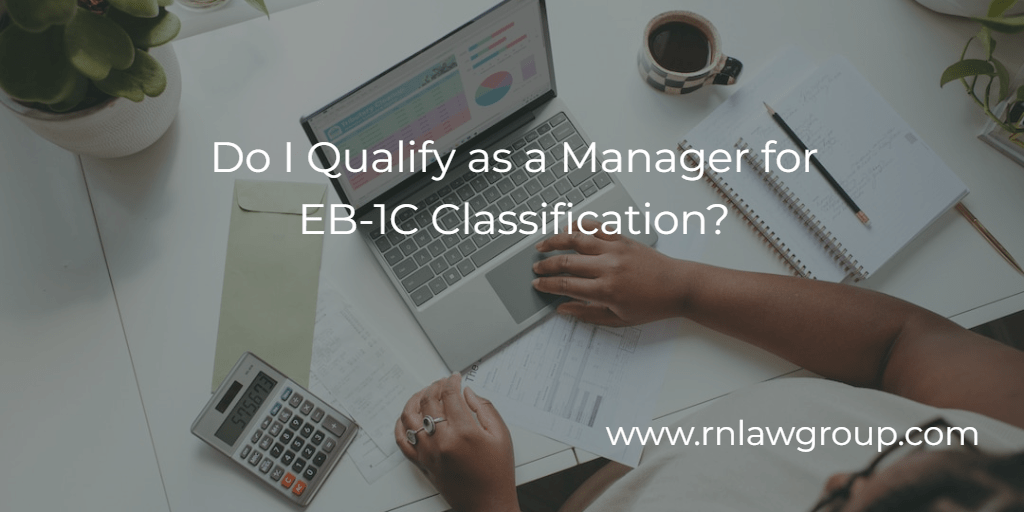
Do I Qualify as a Manager for EB-1C Classification?
The EB-1C classification is an immigrant visa category for multinational executives and managers. In addition to allowing for earlier filing for adjustment of status, an advantage of this category is that it does not require the sponsoring employer to undergo the lengthy PERM labor certification process. The recent availability of premium processing for EB-1C I-140 petitions also allows for expedited processing of 45 days, as opposed to the prior 8-12 month adjudication time.
Common questions regarding EB-1C manager classification include:
Do I need to have worked for the U.S. petitioner abroad in order to qualify?
Yes. The EB-1C classification requires that the beneficiary be directly employed for at least one year by a foreign parent, subsidiary, affiliate, or branch of the U.S. petitioner in a managerial or executive capacity. The beneficiary must be physically outside the U.S. for at least this one-year period of foreign employment; any time the beneficiary spent within the U.S. during their employment with the foreign entity could be deducted from their one-year employment calculation.
This one year of employment abroad must have occurred within the 3-year period immediately preceding the I-140 petition’s filing. If the foreign employment occurred more than 3 years prior to the filing, it must be because the beneficiary was employed in the U.S. by the petitioner or another entity with a qualifying corporate relationship (parent, subsidiary, affiliate, or branch) of the petitioner, such as being in the U.S. in L-1 or H-1B status working for the petitioner.
What is the definition of a manager for purposes of the EB-1C classification?
The EB-1C classification requires that the beneficiary have been employed as a manager or executive abroad, and will also be employed as a manager or executive in the U.S. company. USCIS defines a managerial position as one in which the beneficiary primarily:
- Manages the organization, department, subdivision, function, or component of the organization;
- Supervises and controls the work of other supervisory, professional, or managerial employees;
- Possesses authority to hire and fire or recommend those and other personnel actions (such as promotion and leave authorization) for employees directly supervised; and
- Exercises discretion over the day-to-day operations of the activity or function for which the employee has authority.
Key points are that the beneficiary should be a manager of people, not necessarily of projects or work (unless qualifying as a functional manager, discussed here). The majority (more than 50%) of the beneficiary’s time must be spent on duties that are managerial, as described above, rather than actually performing the work their direct reports are responsible for. A detailed job description is therefore important, with approximate percentages designated to indicate where the majority of the beneficiary’s time is spent.
What documents are typically needed to demonstrate a managerial position?
A crucial piece of supporting evidence in an EB-1C filing is the organizational chart, which indicates the beneficiary’s position, where they fit in the company’s overall hierarchy, and the number and job titles of their direct reports. Two organizational charts should be submitted, indicating the beneficiary’s managerial position abroad, and the expected managerial position in the U.S. The chart should also detail who, if anyone, reports to the beneficiary’s direct reports. The beneficiary generally should not be a “first-line supervisor,” meaning that the applicant’s direct reports should in turn have employees or teams reporting to them.
The exception to the first-line supervisor rule is if the beneficiary’s direct reports are professionals, possessing at least a bachelor’s degree. Profiles of the beneficiary’s direct reports are therefore also important, consisting of each direct report’s job title, job description, the nature of their reporting relationship to the beneficiary, and their alary and education level, backed up by copies of the reportees’ payroll and sometimes degree certificates as verification.
Evidence of the beneficiary’s managerial duties is also helpful, such as copies of performance reviews they have completed for their team, documents showing they were involved in the hiring process, documents or e-mails showing they issued approval for requests among their team, samples of written reports or updates they received, etc.
What if documents from the foreign entity are difficult to obtain?
This is often the case if the beneficiary has been working for the U.S. petitioner for several years before the EB-1C I-140 petition is being filed. In this situation, it is important to note that the organizational chart of the foreign employer that should be submitted with the filing may not match the company’s current structure – it should be a “snapshot” of the hierarchy at the time the beneficiary occupied their managerial position in the foreign company. If it has been several years, the chart may include employees who no longer work at the company, or who are no longer in those positions. The company should do its best to provide a chart matching the structure at the time, and to provide documents that are available as verification (payroll records, personnel reports, e-mail communications, etc.).
What if the foreign entity I was employed with closed or has been acquired before the I-140 petition was filed?
In order to qualify for EB-1C classification, the foreign employer of the beneficiary must be in existence and actively operating from the time the I-140 immigrant petition is filed, until it is adjudicated. If the foreign employer has closed down or ceased operations, the only way an EB-1C petition can still be filed and approved is if another foreign entity qualifies as the “successor-in-interest” to the former foreign employer, and continues to operate from the petition’s filing through adjudication. Therefore, if the original employer has been merged into or acquired by another foreign entity that qualifies as a successor (defined as a corporation that, through amalgamation, consolidation, or other assumption of interests, is vested with the rights and duties of an earlier corporation), the qualifying relationship for EB-1C purposes may be established and the I-140 petition could be processed.
We are committed to assisting our clients with navigating the often lengthy green card process and other challenging immigration matters as an accomplished business immigration law firm in Houston, Texas. Feel free to contact us or set up a consultation to discuss your specific situation related to your travel plans, and how they may affect your pending applications and work authorization.
By: Rebecca Chen
Rebecca Chen is a Partner at Reddy & Neumann. Her representation includes advising clients throughout the non-immigrant and immigrant visa application process, from initial filing, responding to various requests for evidence, and processing at overseas consulates. Her years of experience in the immigration field have made her a knowledgeable resource for complex business immigration matters.

